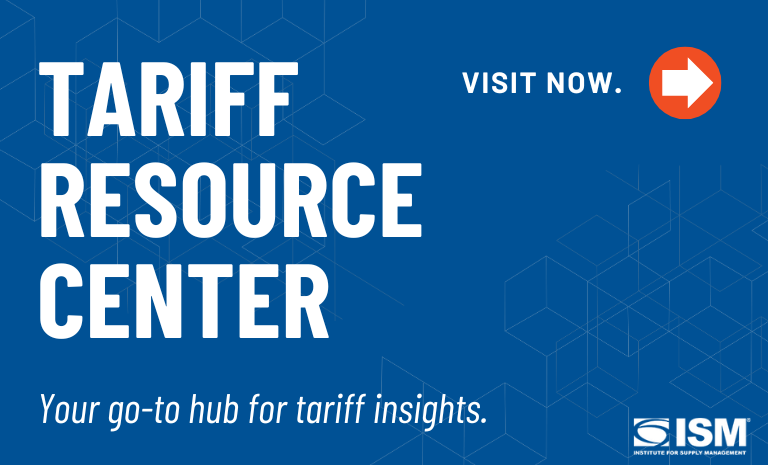Report On Business® Roundup: May Hospital PMI®

Tariffs were the primary concern in May for purchasing and supply executives in health care — as in almost every industry — and was a weighty factor on the Hospital ISM® Report On Business® data and respondents’ comments.
Hospitals, more than perhaps any other segment of the economy, are also bracing for the significant consequences of a sweeping policy bill under debate in Washington. That had little impact on a Hospital PMI® reading of 52 percent that indicated expansion for a 21st consecutive month. However, cuts to Medicaid and the Affordable Care Act (ACA) in the bill will, if it passes, (1) have major implications on how facilities provide care, (2) further trim operating margins and (3) put some facilities (particularly in rural areas) at risk of closure. More on that later.
Regarding tariffs, however, the data for May suggests that hospitals weathered the storm better than other businesses. The three prices indexes — Prices, Prices: Pharmaceuticals and Prices: Supplies — increased by a combined 14 percentage points in May, with two of them above 60 percent. However, panelists reported that group purchasing organization (GPO) agreements and other contracts prevented or capped price increases.
Despite all four key subindexes showing slower growth, the #ISMPMI stayed in expansion territory at 52% in May, the Hospital @ISM® Report On Business® found. #Tariffs were felt in higher prices but had little impact on delivery times. https://t.co/jHOoLC4ISf #economy #healthcare
— Institute for Supply Management (@ism) June 6, 2025
Also, while ISM’s Manufacturing and Services reports indicated longer lead times and tariff-related supply chain bottlenecks in May, the Hospital Supplier Deliveries Index decreased 5 percentage points, though it remained in expansion (or “slower”) territory. Very few panelists reported supply chain difficulties, and the Touchless Orders Index (51.5 percent) returning to expansion indicated more seamless buying.
“There are two camps on tariffs,” Nancy LeMaster, MBA, Chair of the Institute for Supply Management® Hospital Business Survey Committee, told a conference call of reporters on Friday. “One is just going to wait and see because they have contractual protection, and the other group is more proactive.”
She added, “Companies have to protect their profit margins while ensuring inventories. Since the (coronavirus) pandemic, there has been a constant growth in the caliber and the strategy that hospital supply chain professionals are applying to this balance of having the right amount of inventory in an era of margin pressure.”
The Inventories Index increased 6.5 percentage points to return to expansion, and the Inventory Sentiment Index registered above 55 percent, up 6 percentage points. “That shows hospitals know they have too much inventory, but they feel it’s the best option for managing costs and managing patient care,” LeMaster said.
Though patient volumes were mixed — the Business Activity Index indicated slower growth, and the New Orders Index’s status was “unchanged” — the relatively smooth month meant much of the conference call was focused on the future. There are many concerns.
A new COVID-19 variant has been detected in the U.S., and while LeMaster said it was not an alarm bell in May, current conditions don’t bode well for pandemic readiness.
“From an infrastructure perspective, in some ways, we're worse off because we’ve weakened our public health system and weakened people’s confidence in vaccines,” she said. “Tariffs and high prices are staring at us, as well as a disrupted supply chain, with a lot of countries focus on nationalism and what’s in it for them.”
And the budget bill cuts US$600 billion and could remove up to 11 million people from Medicaid, according to analysis by the Congressional Budget Office. Also, ACA enrollment windows and Supplemental Nutrition Assistance Program (SNAP) eligibility requirements would be tightened.
Hospital #ISMPMI survey respondents: “#Tariffs-related cost increases and supply disruptions are on the doorstep. Very little help from partners, distributors or manufacturers on details.” Also, “Tariff concerns continue to distract.” https://t.co/cEHGfl32Ga #economy #healthcare
— Dan Zeiger (@ZeigerDan) June 6, 2025
While the threat of federal program cuts is hardly new to hospitals, they are preparing for “protective positioning” — without really knowing what that looks like, LeMaster said.
“I think (hospital systems) are in a paralyzed stage,” she said. “There are tools that were fine-tuned during the pandemic, like telemedicine, which enable them to still take care of people. But regarding (the proposed cuts), at this point, I haven’t heard a lot of good ideas about exactly how we’re going to manage this.”
In case you missed the Report On Business® Roundup on the release of the May Manufacturing PMI®, you can read it here. The Roundup on the release of the Services PMI® can be read here. For the most up-to-date content on the three indexes in the ISM® Report On Business® family, use #ISMPMI on X, formerly known as Twitter.

